Related Research Articles

Feudalism, also known as the feudal system, was the combination of the legal, economic, military, cultural and political customs that flourished in medieval Europe between the 9th and 15th centuries. Broadly defined, it was a way of structuring society around relationships that were derived from the holding of land in exchange for service or labour. Although it is derived from the Latin word feodum or feudum (fief), which was used during the Medieval period, the term feudalism and the system which it describes were not conceived of as a formal political system by the people who lived during the Middle Ages. The classic definition, by François Louis Ganshof (1944), describes a set of reciprocal legal and military obligations which existed among the warrior nobility and revolved around the three key concepts of lords, vassals, and fiefs.

A fief was a central element in medieval contracts based on feudal law. It consisted of a form of property holding or other rights granted by an overlord to a vassal, who held it in fealty or "in fee" in return for a form of feudal allegiance, services, and/or payments. The fees were often lands, land revenue or revenue-producing real property like a watermill, held in feudal land tenure: these are typically known as fiefs or fiefdoms. However, not only land but anything of value could be held in fee, including governmental office, rights of exploitation such as hunting, fishing or felling trees, monopolies in trade, money rents and tax farms. There never existed a standard feudal system, nor did there exist only one type of fief. Over the ages, depending on the region, there was a broad variety of customs using the same basic legal principles in many variations.

A vassal or liege subject is a person regarded as having a mutual obligation to a lord or monarch, in the context of the feudal system in medieval Europe. While the subordinate party is called a vassal, the dominant party is called a suzerain. The rights and obligations of a vassal are called vassalage, while the rights and obligations of a suzerain are called suzerainty. The obligations of a vassal often included military support by knights in exchange for certain privileges, usually including land held as a tenant or fief. The term is also applied to similar arrangements in other feudal societies.
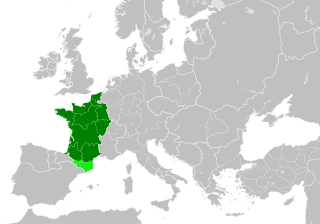
The Kingdom of France in the Middle Ages was marked by the fragmentation of the Carolingian Empire and West Francia (843–987); the expansion of royal control by the House of Capet (987–1328), including their struggles with the virtually independent principalities, and the creation and extension of administrative/state control in the 13th century; and the rise of the House of Valois (1328–1589), including the protracted dynastic crisis against the House of Plantagenet and their Angevin Empire, cumulating in the Hundred Years' War (1337–1453), which laid the seeds for a more centralized and expanded state in the early modern period and the creation of a sense of French identity.

The Duchy of Normandy grew out of the 911 Treaty of Saint-Clair-sur-Epte between King Charles III of West Francia and the Viking leader Rollo. The duchy was named for its inhabitants, the Normans.

The Treaty of Paris was a treaty between Louis IX, King of France and Henry III, King of England, agreed to on 4 December 1259, ending 100 years of conflicts between the Capetian and Plantagenet dynasties.

Château Gaillard is a medieval castle ruin overlooking the River Seine above the commune of Les Andelys, in the French department of Eure, in Normandy. It is located some 95 kilometres (59 mi) north-west of Paris and 40 kilometres (25 mi) from Rouen. Construction began in 1196 under the auspices of Richard the Lionheart, who was simultaneously King of England and feudal Duke of Normandy. The castle was expensive to build, but the majority of the work was done in an unusually short period of time. It took just two years and, at the same time, the town of Petit Andely was constructed. Château Gaillard has a complex and advanced design, and uses early principles of concentric fortification; it was also one of the earliest European castles to use machicolations. The castle consists of three enclosures separated by dry moats, with a keep in the inner enclosure.

The Battle of Blanchetaque was fought on 24 August 1346 between an English army under King Edward III and a French force commanded by Godemar du Fay. The battle was part of the Crécy campaign, which took place during the early stages of the Hundred Years' War. After landing in the Cotentin Peninsula on 12 July, the English army had burnt a path of destruction through some of the richest lands in France to within 20 miles (32 km) of Paris, sacking a number of towns on the way. The English then marched north, hoping to link up with an allied Flemish army which had invaded from Flanders. They were outmanoeuvred by the French king, Philip VI, who garrisoned all of the bridges and fords over the River Somme and followed the English with his own field army. The area had previously been stripped of food stocks by the French, and the English were essentially trapped.

The title of Duke was the highest hereditary title in the French nobility during the time of the monarchy in France.

The Battle of Caen was an assault conducted on 26 July 1346 by forces from the Kingdom of England, led by King Edward III, on the French-held town of Caen and Normandy as a part of the Hundred Years' War.
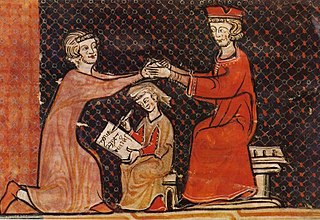
Homage in the Middle Ages was the ceremony in which a feudal tenant or vassal pledged reverence and submission to his feudal lord, receiving in exchange the symbolic title to his new position (investiture). It was a symbolic acknowledgement to the lord that the vassal was, literally, his man (homme). The oath known as "fealty" implied lesser obligations than did "homage". Further, one could swear "fealty" to many different overlords with respect to different land holdings, but "homage" could only be performed to a single liege, as one could not be "his man" to more than one "liege lord".
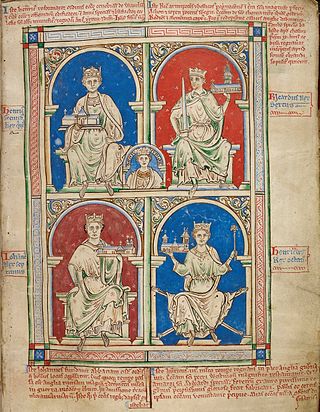
In the history of England, the High Middle Ages spanned the period from the Norman Conquest in 1066 to the death of King John, considered by some historians to be the last Angevin king of England, in 1216. A disputed succession and victory at the Battle of Hastings led to the conquest of England by William of Normandy in 1066. This linked the Kingdom of England with Norman possessions in the Kingdom of France and brought a new aristocracy to the country that dominated landholding, government and the church. They brought with them the French language and maintained their rule through a system of castles and the introduction of a feudal system of landholding. By the time of William's death in 1087, England formed the largest part of an Anglo-Norman empire, ruled by nobles with landholdings across England, Normandy and Wales. William's sons disputed succession to his lands, with William II emerging as ruler of England and much of Normandy. On his death in 1100 his younger brother claimed the throne as Henry I and defeated his brother Robert to reunite England and Normandy. Henry was a ruthless yet effective king, but after the death of his only male heir William Adelin, he persuaded his barons to recognise his daughter Matilda as heir. When Henry died in 1135 her cousin Stephen of Blois had himself proclaimed king, leading to a civil war known as The Anarchy. Eventually Stephen recognised Matilda's son Henry as his heir and when Stephen died in 1154, he succeeded as Henry II.
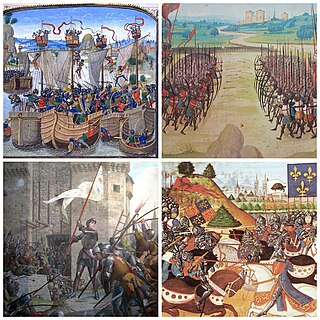
The Hundred Years' War was a series of armed conflicts between the kingdoms of England and France during the Late Middle Ages. It originated from English claims to the French throne. The war grew into a broader power struggle involving factions from across Western Europe, fueled by emerging nationalism on both sides.
In the Middle Ages, the ban or banality was originally the power to command men in war and evolved into the general authority to order and to punish. As such, it was the basis for the raising of armies and the exercise of justice. The word is of Germanic origin and first appears in fifth-century law codes. Under the Franks it was a royal prerogative, but could be delegated and, from the tenth century, was frequently usurped by lesser nobles.

Feudalism as practiced in the Kingdoms of England during the medieval period was a state of human society that organized political and military leadership and force around a stratified formal structure based on land tenure. As a military defence and socio-economic paradigm designed to direct the wealth of the land to the king while it levied military troops to his causes, feudal society was ordered around relationships derived from the holding of land. Such landholdings are termed fiefdoms, traders, fiefs, or fees.
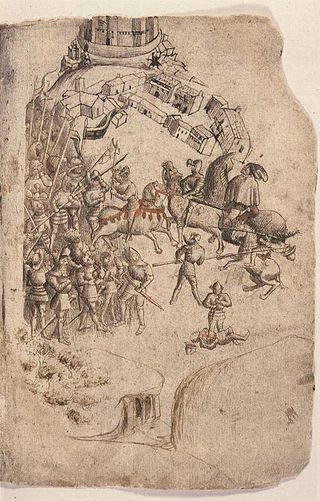
Warfare in Medieval Scotland includes all military activity in the modern borders of Scotland, or by forces originating in the region, between the departure of the Romans in the fifth century and the adoption of the innovations of the Renaissance in the early sixteenth century. In this period conflict developed from minor raids to major conflicts, incorporating many of the innovations of continental warfare.

Feudal duties were the set of reciprocal financial, military and legal obligations among the warrior nobility in a feudal system. These duties developed in both Europe and Japan with the decentralisation of empire and due to lack of monetary liquidity, as groups of warriors took over the social, political, judicial, and economic spheres of the territory they controlled. While many feudal duties were based upon control of a parcel of land and its productive resources, even landless knights owed feudal duties such as direct military service in their lord's behest. Feudal duties were not uniform over time or across political boundaries, and in their later development also included duties from and to the peasant population, such as abergement.

The siege of Aiguillon, an episode in the Hundred Years' War, began on 1 April 1346 when a French army commanded by John, Duke of Normandy, laid siege to the Gascon town of Aiguillon. The town was defended by an Anglo-Gascon army under Ralph, Earl of Stafford.

Lancaster's chevauchée of 1346 was a series of offensives directed by Henry, Earl of Lancaster, in southwestern France during autumn 1346, as a part of the Hundred Years' War.

English offensives in 1345–1347, during the Hundred Years' War, resulted in repeated defeats of the French, the loss or devastation of much French territory and the capture by the English of the port of Calais. The war had broken out in 1337 and flared up in 1340 when the king of England, Edward III, laid claim to the French crown and campaigned in northern France. There was then a lull in the major hostilities, although much small-scale fighting continued.
References
- 1 2 3 Theodore Evergates (1995), "Ban, Banalité", in William W. Kibler; Grover A. Zinn (eds.), Medieval France: An Encyclopedia, Garland, pp. 175–176.
- ↑ "arrière-ban, n." OED Online, Oxford University Press, January 2018. Accessed 18 February 2018.
- 1 2 3 4 John Bell Henneman, Jr. (2017), "Arrière-ban", in William W. Kibler; Grover A. Zinn (eds.), Medieval France: An Encyclopedia, Taylor & Francis, pp. 71–72, ISBN 978-1-351-66566-7 , retrieved 7 January 2021
- 1 2 Allmand, Christopher (4 February 1988). The Hundred Years War: England and France at War C.1300-c.1450. Cambridge University Press. p. 95. ISBN 978-0-521-31923-2 . Retrieved 7 January 2021.
- ↑ Collins, James B. (28 September 1995). The State in Early Modern France. Cambridge University Press. p. 20. ISBN 978-0-521-38724-8 . Retrieved 7 January 2021.
- ↑ F. M. Powicke (1913), The Loss of Normandy (1189–1204): Studies in the History of the Angevin Empire, Manchester University Press, p. 311–312.
- ↑ Jonathan Sumption (1991), The Hundred Years War I: Trial by Battle, Philadelphia: University of Pennsylvania Press, ISBN 0-8122-1655-5 , p. 184
- ↑ Collins, James B. (28 September 1995). The State in Early Modern France. Cambridge University Press. p. 62. ISBN 978-0-521-38724-8 . Retrieved 7 January 2021.